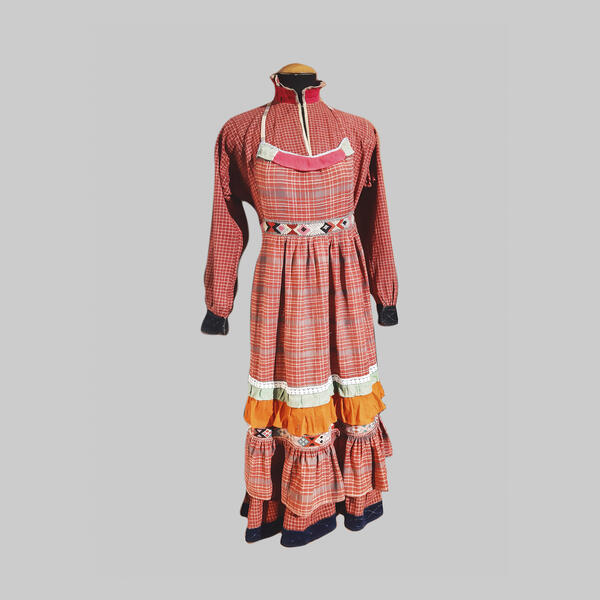The Nagaybaks are a small group of people living in the Chelyabinsk Region, mainly in the Nagaybaksky and Chebarkulsky Districts. They mainly reside in the village Fershampenuaz, the administrative center of the Nagaybaksky District. They speak the Nagaybak sub-dialect of the Tatar language. Until 1917, they consisted of the baptized Tatar-Cossack population and were considered a kind of an ethnoreligious social group of the Orenburg Governorate. In the Russian Empire, the Nagaybaks belonged to the Orenburg Cossack caste.
Researcher Irek Atnagulov estimates that the Nagaybak population changed as follows: 1866 — 4,287 people, 1897 — 7,812 people, 1926 — 7,722 people, 1959 — about 8,700 people, 1979 — about 9,700 people, 1989 — about 12,000 people, 2002 — 9,600 people, and 2010 — 8,148 people.
The museum’s collection includes an old national Southern Ural costume, which belonged to a Nagaybak woman (Nagaybaks are a small ethnic group in the region) and dates back to the 1910s. The costume is hand-sewn and made of homespun fabrics. It consists of two items: a “kulmek” undershirt dress and an “alchuprek” apron. The undershirt dress resembles a traditional Tatar dress. It is a tunic with narrow cuffs, a low stand-up collar, and a frill tape at the hem. The costumes of the Nagaybak women were usually decorated with two strips of colored frills, a lace strip above them, and a woven strip along the lower edge of the dress. The cuffs and border of the dress are hemmed with dense black velvet fabric with a cotton wrap.
The undershirt dress is sewn from dark red motley fabric with a small checkered pattern. The motley fabric was usually homespun and made of multicolored coarse linen or cotton yarn. The dress was worn under a narrow bib apron made of red motley fabric with a larger checkered pattern.
The Nagaybak women preferred red clothes because the red color was considered to be the most festive and elegant. The homespun cloth was typically used to make a costume’s base, while the details like tunic frills and apron ties were made using factory material. The full outfit also includes a ‘zhilan, ’ a sleeveless vest made of wool or silk, and a headdress reflecting the age and social status of the woman.
Researcher Irek Atnagulov estimates that the Nagaybak population changed as follows: 1866 — 4,287 people, 1897 — 7,812 people, 1926 — 7,722 people, 1959 — about 8,700 people, 1979 — about 9,700 people, 1989 — about 12,000 people, 2002 — 9,600 people, and 2010 — 8,148 people.
The museum’s collection includes an old national Southern Ural costume, which belonged to a Nagaybak woman (Nagaybaks are a small ethnic group in the region) and dates back to the 1910s. The costume is hand-sewn and made of homespun fabrics. It consists of two items: a “kulmek” undershirt dress and an “alchuprek” apron. The undershirt dress resembles a traditional Tatar dress. It is a tunic with narrow cuffs, a low stand-up collar, and a frill tape at the hem. The costumes of the Nagaybak women were usually decorated with two strips of colored frills, a lace strip above them, and a woven strip along the lower edge of the dress. The cuffs and border of the dress are hemmed with dense black velvet fabric with a cotton wrap.
The undershirt dress is sewn from dark red motley fabric with a small checkered pattern. The motley fabric was usually homespun and made of multicolored coarse linen or cotton yarn. The dress was worn under a narrow bib apron made of red motley fabric with a larger checkered pattern.
The Nagaybak women preferred red clothes because the red color was considered to be the most festive and elegant. The homespun cloth was typically used to make a costume’s base, while the details like tunic frills and apron ties were made using factory material. The full outfit also includes a ‘zhilan, ’ a sleeveless vest made of wool or silk, and a headdress reflecting the age and social status of the woman.



